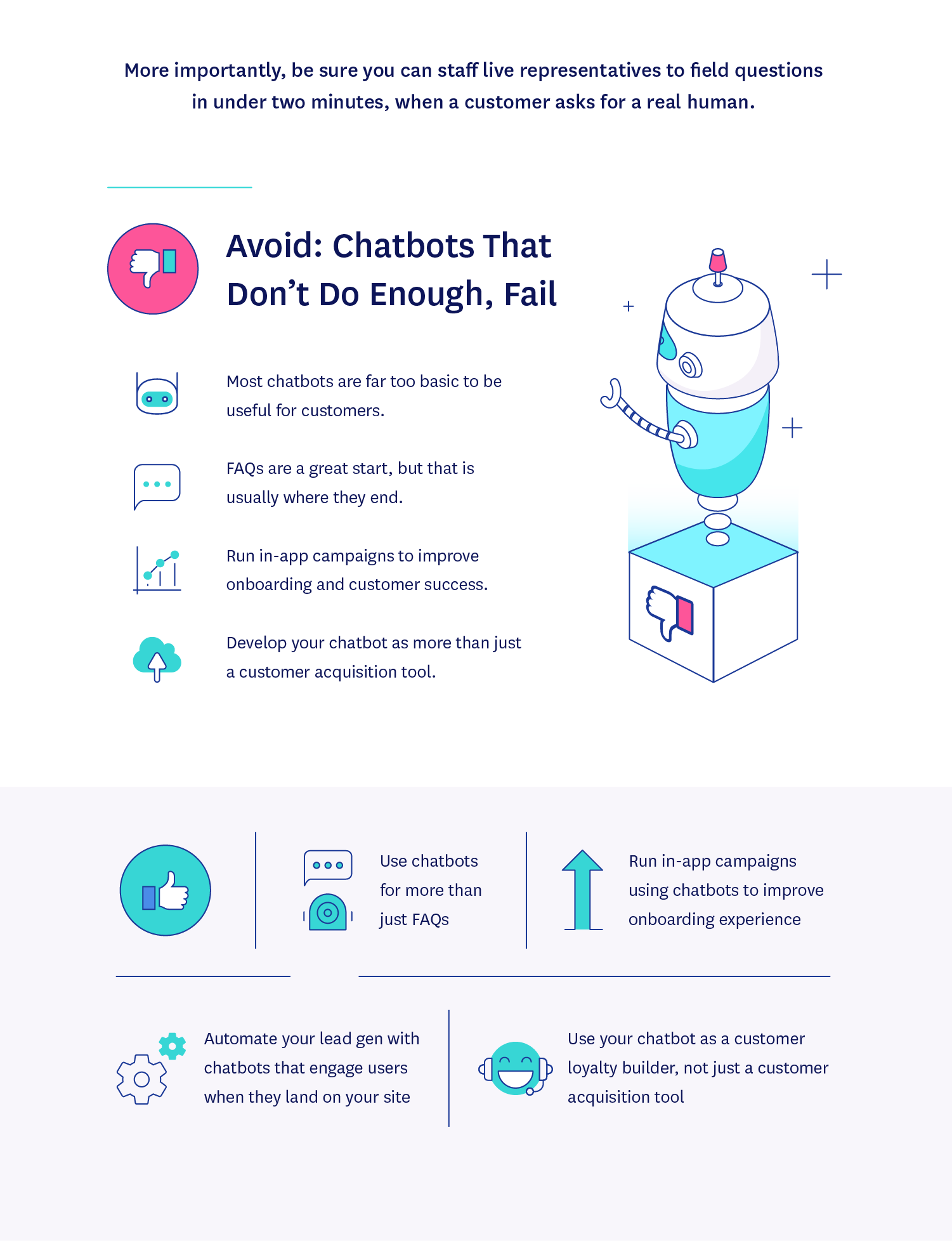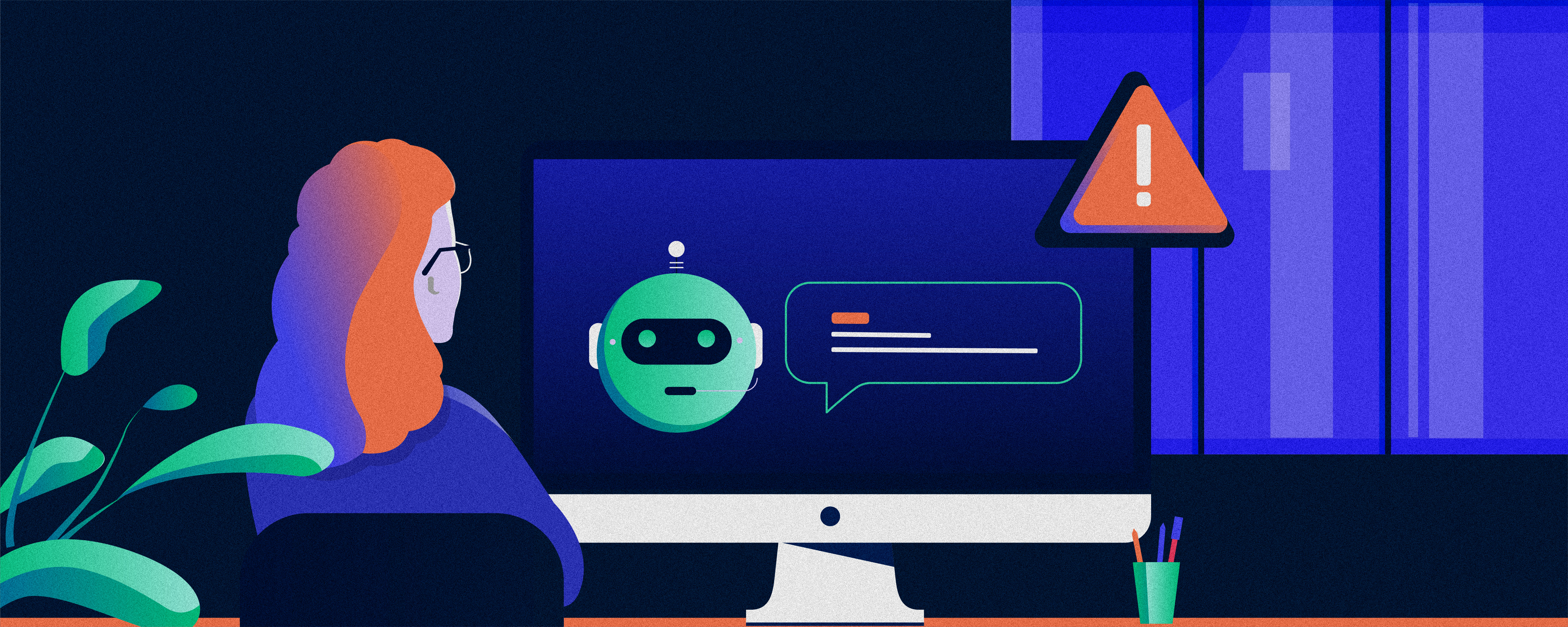How to Avoid these 3 Chatbot Nightmare Examples that Completely Backfired
Live-chat is a stellar way to improve customer service and support success for any business. And increasingly, chatbots are becoming a way to automate vital business interactions with potential leads and customers any time of the day, even when workers aren’t present. Typically, to fill live-chat spots, you will need more manual labor. More employees and increasing overhead. But chatbots have proven themselves to be effective at solving most consumer inconveniences until a live operator takes over.
With phone support showing downward trends and live-chat showing upward trends, customers are getting access to support on their preferred medium. But live-chat and chatbots alone do not guarantee results. In fact, chatbots can backfire dramatically and aren’t as easy as setting them live and watching efficiency go up.
Before considering chatbots for your company, be aware of these potential chatbot nightmares (and how you can avoid them).
1. Chatbots Trying to Tackle High-Level Tasks Often Fail
Chatbots are a fantastic way to automate live-chat situations that would normally be too low-impact for your support reps to handle. For instance, common frequently asked questions that arise from visitors who are on your website for the first or second time. These low-level queries are asked over and over, so simplifying the process for your team and consumers is only common sense.
These questions are low-level in terms of overall business growth and impact, but multiple per day per support rep can have a high impact on efficiency. If your support reps are spending 30-60 minutes per day answering these questions, that’s a problem. That’s 30 to 60 minutes of support better spent elsewhere, like developing new processes, writing new knowledge base articles, and updating old support documents.
While this is a great first step, many businesses take it too far with chatbots and expect them to replace overall workforces. Oftentimes, businesses go wrong when they implement chatbots, thinking that chatbots are the end-all-be-all solution to automation and growth. While it started with replacing tedious tasks for the support team, chatbots are tempting to implement everywhere. Why not save on efficiency in every single sector, right?
While it’s smart thinking, chatbots are rarely evolved enough to replace human contact in critical situations. Bots that can perform high-level tasks often take years to develop and even so, still lack the ability to add context to the chat.
In the end, these costs are likely higher than a single support team member in terms of:
– Development
– Research
– Maintenance
– Potential loss of customers due to bad experiences
Use chatbots to answer and field easy questions like FAQs or directing users to a knowledge base. Then if that doesn’t solve the problem, direct users into live operator takeover. Chatbots can become a nightmare to both you and the customer when they try to do too much. Chatbots, as is, should serve as the gatekeeper to support for your team.
If users are asking common questions, the chatbot can solve them. Do they want to upgrade their plan? The chatbot can still do that. But if they want to discuss add-ons to their account on a per month basis, you will need live operators to jump aboard and assist.

2. Having Slow Response Times (Or Not Responding At All) Is Devastating For Service Ratings
Customer support and service ratings can literally make or break your business. According to a 2018 report from NewVoiceMedia, subpar customer service costs businesses over $75 billion dollars every year. And that number is up $13 billion since 2016, showing an up and to the right trend in poor customer service and the impacts it has on a business.
The problem with most customer service channels is balancing support staff/overhead with incoming requests. Sometimes, that’s nearly impossible to account for. Daily fluctuations can dramatically impact efficiency or leave agents asleep at their desk.
Live-chat and chatbots present a prime opportunity for modern day businesses to offer instant customer gratification and destroy this business pain point. Customers in the modern day have everything at their fingertips. Whether it’s apps, websites, information, or content, they can and should be able to access it anywhere, everywhere, and whenever they need it. But the studies don’t lie:
Most businesses don’t respond fast enough on chat platforms for support. While chat is dominating in customer service preferences among consumers businesses are still not responding fast enough, or even failing to respond at all. The 2018 report on chat found some interesting statistics:
– 21% of support requests on chat aren’t answered.
– 23% of companies aren’t getting user information to assist in chat or chatbot relevance
– Response times are improving, but many are still too slow
Slow response times can kill your growth potential and negatively impact service ratings. And according to the study, many companies are still too slow making a customer wait for 9 minutes to speak to a representative.
If your average time on site is just a few minutes per visitor, you can’t reasonably expect them to wait double or even triple the time to speak to someone. The best way to counteract this is by using a chatbot that engages users before they realize they need assistance.
This works two-fold:
– It engages the customer and provides incentive for them to stick around
– It gives more context for your live operators as to what they are interested in, giving them time to prepare for a conversation to run smoothly
With triggered messages, your bots can interact with a customer based on what page they view and even select products or services.
Doing so will deliver a great, instant gratification experience to customers with your chatbot, eliminating potential wait times by giving your reps time to prepare behind the scenes.

3. Chatbots That Do Too Little Can Sabotage Service
As we discussed earlier, chatbots that try to accomplish every single task often fail. They produce more harm than good when trying to nail every high-level task, quickly turning into a nightmare for customer support reps and your service ratings.
Conversely, chatbots on the other end of the spectrum are just as nightmare-inducing. Chatbots that do too little can sabotage your service. In fact, if chatbot experiences are bad, you can bet that people will quickly get frustrated and bounce from your website.
Your chatbot should be more than a placeholder that says “Thanks for contacting, a support rep will be with you shortly!” or an FAQ bot. It should be able to direct people to the right content and learn as it gets feedback. Nightmares arise with chatbots when they stop responding or delivering information, leaving the visitor confused, and ultimately, frustrated.
Your chatbots should be directly linked to your knowledge base, allowing them to pull information based on keywords and topics like “Shipping” or “Making Payments” to deliver key information and close the ticket.

Chatbots that can do more than be FAQ responders will provide tons of value for your business and support team. Beyond that, your bots should be able to run in-app campaigns, engaging current customers too. Chatbots, while very capable of it, aren’t just for lead generation. They are for loyal customers who need assistance, too.
For instance, guiding new users with onboarding tips and helpful messages to encourage them, while providing links to your knowledge base to supplement their potential questions.
Loyal customers deserve great support, too. And new, onboarded customers are going to present a big challenge in terms of volume to your support team. It’s likely that they will have countless questions that can bog down support and drain efficiency. Your chatbot should be well integrated to your existing knowledge base information for the biggest impact. These are key factors to look at when deciding on chatbots and whether to implement them with your support team.

Conclusion
Customer support is trending away from calls are further towards live-chat and chatbots for automation. Chatbots are a fantastic way to reduce time per ticket and free up support staff for bigger tasks like writing knowledge base articles and serving detailed customer issues. But they aren’t without their challenges, and they should always be assessed before implementation to your business.
Find a chatbot provider that offers chatbots that strike a balance between being too basic and too complex. The more complex chatbots become, the bigger your investment and ongoing maintenance needs are, as well as potential complications. The simpler they are, the less value they provide for both your team and the customer engaging with it.
Ensure that chatbots take the reigns and engage users first to provide excellent support and time for your live agents to jump in and provide human context. Chatbots can’t replace a well-oiled customer service team, but when implemented on the right scale, can free up their time for unparalleled efficiency.




